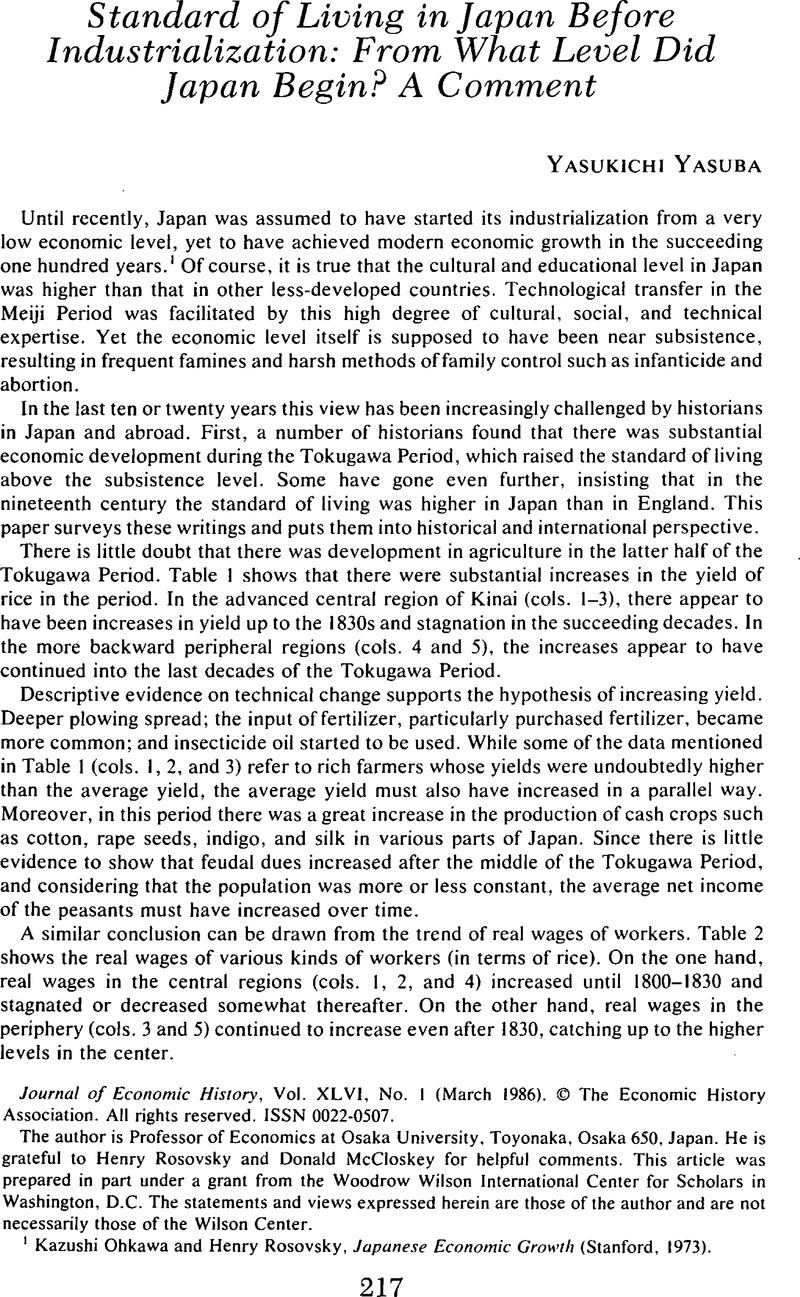Published online by Cambridge University Press: 03 March 2009

1 Ohkawa, Kazushi and Rosovsky, Henry, Japanese Economic Growth (Stanford, 1973).Google Scholar
2 Umemura, Mataji, “Bakumatsu no Keizai Hatten” [Economic development towards the end of the Tokugawa Period], Kenkyūkai, Kindai Nihon, ed., Bakumatsu-Ishin no Nihon (Tokyo, 1981).Google Scholar For a similar and even more forceful assertion, see Hanley, Susan B. and Yamamura, Kozo, Economic and Demographic Change in Preindustrial Japan, 1600–1868 (Princeton, 1977).Google Scholar
3 Hanley, Susan B., “A High Standard of Living in Nineteenth-Century Japan: Fact or Fantasy?” this Journal, 43 (03 1983), p. 183.Google Scholar
4 Ibid., p. 188.Google Scholar
6 Kinugawa, Taichi, Hompō Menshi Bōseki-shi, Dai-2-kan [History of cotton spinning in this country, vol. 2] (Tokyo, 1937), p. 420.Google Scholar
7 Wood, George Henry, “The Statistics of Wages in the United Kingdom during the Nineteenth Century, (Part XV) the Cotton Industry) the Cotton Industry. ” Journal of the Royal Statistical Society, 73 (01 1910), p. 52.Google Scholar
8 Hatano, Yoshihiro, Chūgoku Kindai Kōgyōshi no Kenkyū [Studies on early industrialization in China] (Tokyo, 1961), pp. 288–89.Google Scholar
9 Ohkawa, Kazushi, “Initial Conditions: Economic Level and Structure,” Ohkawa, Kazushi and Hayami, Yūjiro, eds., Japan's Historical Development Experience and Contemporary Developing Countries: Issues for Comparative Analysis (Tokyo, 1978), p. 27.Google Scholar
10 Kuznets, Simon, “Quantitative Aspects of the Economic Growth of Nations: I. Levels and Variability of Rates of Growth,” Economic Development and Cultural Change, 5 (10 1956), p. 53.CrossRefGoogle Scholar
11 Kravis, Irving B., Heston, Alan W., and Summers, Robert, “Real GDP Per Capita for More than One Hundred Countries,” The Economic Journal, 88 (06 1978), p. 216.CrossRefGoogle Scholar
12 Hanley, “High Standard,” p. 190.Google Scholar
13 Nishikawa, Shunsaku, “Productivity, Substance, and By-Employment in the Mid-Nineteenth Century Chōshū,” Explorations in Economic History, 15 (01 1978), p. 82.CrossRefGoogle Scholar
14 Hayami, Yūjiro, Nihon Nōgyō no Seichō Katei [The growth process of Japanese agriculture] (Tokyo, 1973), p. 65.Google Scholar
15 Hanley, “High Standard,” p. 190.Google Scholar
16 Suda, Keizō, ō-jiin Kakochō no Kenkyū [Studies on the record of deaths of O-Temple in Hida] (Gifu Prefecute, 1973), pp. 430–40.Google Scholar
17 Yasuba, Yasukichi, “Another Look at the Tokugawa Heritage with Special Reference to Social Conditions,” Ohkawa and Hayami, eds., Japan's Historical Development Experience, p. 4.Google Scholar In order to reconstitute the population, it was assumed that migration can be neglected, For the British life expectancy, see Wrigley, E. A., Schofield, R. S., The Population History of England, 1541–1871 (Cambridge, Mass., 1981), p. 230.Google Scholar
18 Based on Kuznets's figure of $227 prices. Kuznets, Simon, Economic Growth of Nations: Total Output and Production Structure (Cambridge, Mass., 1971). p. 24.CrossRefGoogle Scholar
19 Mitchell, B. R. and Deane, Phyllis, Abstract of British Historical Statistics (London, 1971), pp. 471–72.Google Scholar
20 Hayami, Nihon Nōgyō, p. 70.Google Scholar
21 Fogel, Robert W., “Nutrition and the Decline in Mortality since 1700: Some Preliminary Findings,” NBER Working Paper, no. 1402 (1984), p. 52.Google Scholar
22 Hanley, “High Standard,” p. 191.Google Scholar
23 Ibid., p. 187.Google Scholar
24 Kaheiseido Chōsakai Hōkoku [The Report of the Committee on the Monetary System] (Tokyo, 1895), Appendix, pp. 306–7.Google Scholar
25 van Bath, B. H. Slicher, De Agrarische Geschiedenis van West-Europa (500–1850),Google Scholar English translated by Ordish, Olive, The Agrarian History of Western Europe, A.D. 500–1850 (New York, 1963), p. 87.Google Scholar
26 The original Indian figure of $47 in 1965 prices was M. Mukherjee's. Quoted from Kuznets, Simon, Economic Growth of Nations: Total Output and Production Structure (Cambridge, Mass., 1971), p. 31. The ratio of GDP to NNP was assumed to be 1.06 as in 1960. Price changes and exchange rate changes between 1965 and 1970 were taken into account by the series in International Financial Statistics.CrossRefGoogle Scholar Finally, the 1970 figure was adjusted, using the converter given in Kravis, Heston, and Summers, “Real GDP,” p. 216.Google Scholar